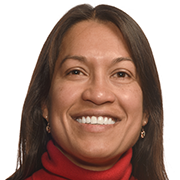
Rachel N. Chandra, PharmD, MPH, FASHP ([email protected]) is a Clinical pharmacy practitioner (CPP) at the Dayton Veterans Affairs Medical Center. She is currently on a 20% detail with the Office of Health Equity (OHE) for Veterans Health Administration. In Dayton, Rachel serves as the postgraduate year 1 (PGY1) residency program director and CPP in the heart failure multi-professional clinic. As a CPP some other areas of involvement include R&D chair, ethics consultation and medication safety. At OHE, Rachel works with the team to support quality improvement initiatives nationally with a focus of narrowing Health Disparities gaps.
Rachel received a Bachelor of Science from St John’s University, then completed a PharmD from Midwestern University. She obtained a PGY1 residency at Penn State Milton S Hershey Medical Center and heart failure training at The Ohio State University. In 2018, Rachel completed a Master of Public Health with a focus on health promotion and disease prevention.
Her service to ASHP includes Ohio delegate to the ASHP House of Delegates and a member of the Council on Therapeutics. Rachel is a past president of the Dayton- area chapter of OSHP. Rachel is a co-author of ASHP’s position statement on the “Pharmacist’s Role in Public Health.”
The landscape of healthcare is in a continuous flux as innovative technologies and practices merge to enhance patient outcomes. We inherently seek evolution. I think of Steve Jobs words: “The people who are crazy enough to think they can change the world are the ones who do.” The nation is at this pivotal point where addressing racism and injustice cannot be ignored. To this point, pharmacists targeting Health Disparities is seeking justice for the populations we serve, through our professional activities.
Ambulatory care practices, community and outpatient clinics are patient facing opportunities where the pharmacy workforce makes an impact daily. I believe the profession is at a juncture to provide the necessary training and education for the pharmacy workforce to assess and address those social determinants contributing to health disparities. As we have practiced in a manner to enhance patient safety and improve outcomes, the additional layers of seeking pharmacoequity, identifying and addressing health disparities is our pivotal time for evolution today.
With diversity in collaboration, all of this is possible. I believe collectively we can empower pharmacists to identify and address determinants of health that will lead to improved patient outcomes for all patients. My deepest thanks for your consideration as chair of this section.
